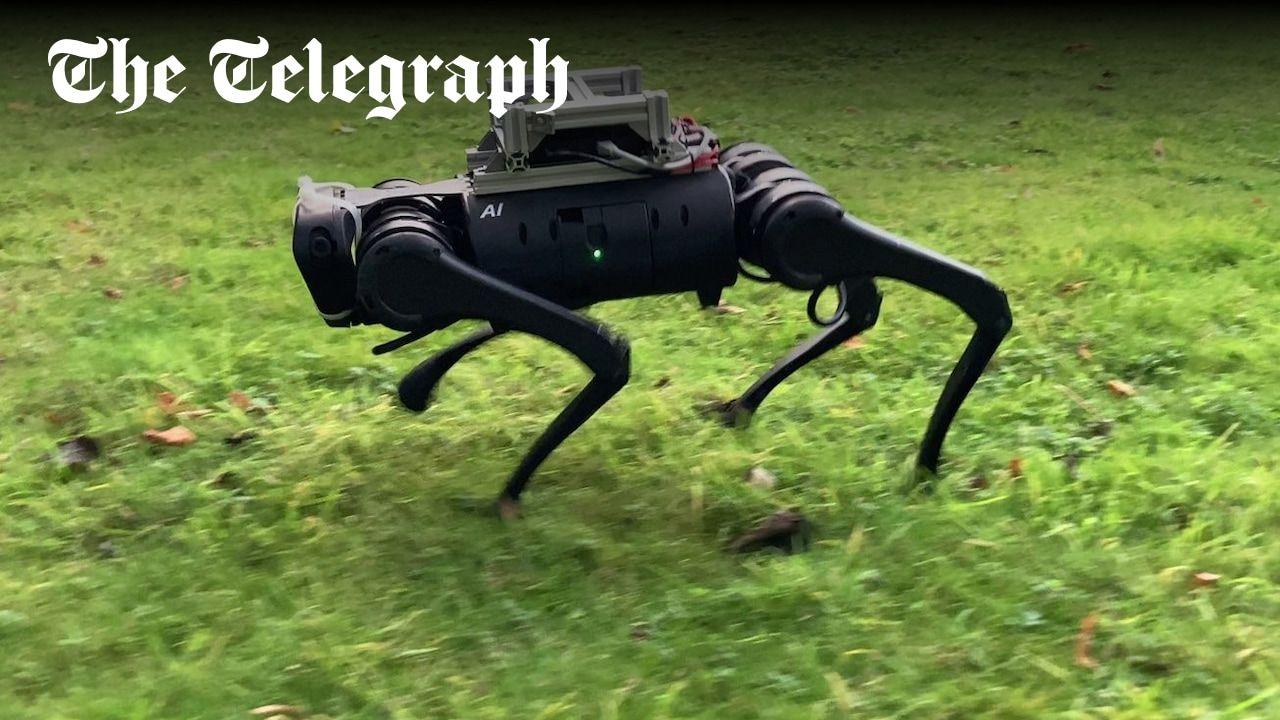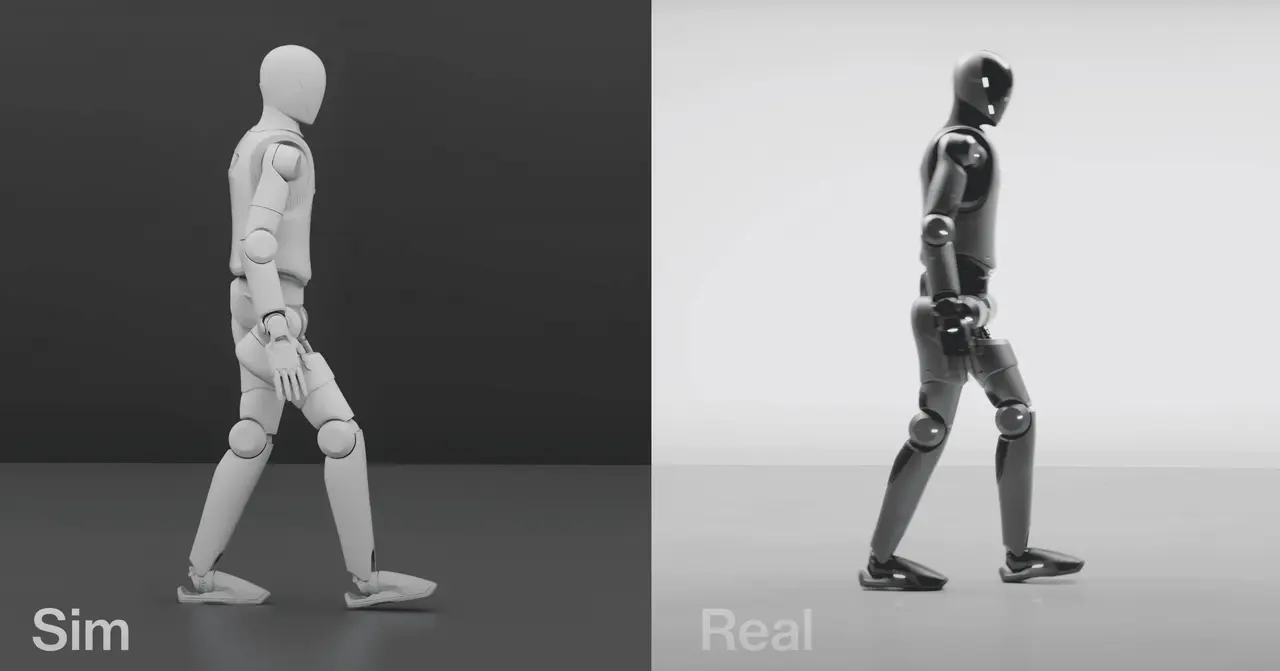Animal-Inspired AI Robot 'Clarence' Learns to Navigate Unfamiliar Terrain Autonomously
2 Sources
2 Sources
[1]
Animal-inspired AI robot learns to navigate unfamiliar terrain
Researchers have developed an artificial intelligence (AI) system that enables a four-legged robot to adapt its gait to different, unfamiliar terrain, just like a real animal, in what is believed to be a world first. The work has been published in Nature Machine Intelligence. The pioneering technology allows the robot to change the way it moves autonomously, rather than having to be told when and how to alter its stride like the current generation of robots. This advance is seen as a major step toward potentially using legged robots in hazardous settings where humans might be put at risk, such as nuclear decommissioning or search and rescue, where the inability to adapt to the unknown could cost lives. For the study, conducted by the University of Leeds and University College London (UCL), the researchers took inspiration from the animal kingdom to teach the robot to navigate terrain that it had never seen before. This included four-legged animals such as dogs, cats and horses, which are adept at adjusting to different landscapes. These animals switch the way they move to save energy, maintain balance, or respond quickly to threats. The researchers have created a framework that can teach robots how to transition between trotting, running, bounding and more, just like mammals do in nature. Switching gaits when needed By embedding within the AI system the same strategies animals use to navigate an unpredictable world, the robot rapidly learns to switch gaits on the fly, in response to the terrain. Thanks to the data-processing power of AI, the robot -- nicknamed "Clarence"- learned the necessary strategies in just nine hours, considerably faster than the days or weeks most young animals take to confidently cross different surfaces. In the Nature Machine Intelligence paper, first author Joseph Humphreys, postgraduate researcher in the School of Mechanical Engineering at Leeds, explains how the framework enables the robot to change its stride in accordance with its environment, overcoming a variety of terrains including uneven timber, loose wood chips, and overgrown vegetation, without any alterations to the system itself. He said, "Our findings could have a significant impact on the future of legged robot motion control by reducing many of the previous limitations around adaptability." He added, "This deep reinforcement learning framework teaches gait strategies and behavior inspired by real animals -- or 'bio-inspired' -- such as saving energy, adjusting movements as needed, and gait memory, to achieve highly adaptable and optimal movement, even in environments never previously encountered. "All of the training happens in simulation. You train the policy on a computer, then take it and put it on the robot and it is just as proficient as in the training. It's similar to the Matrix, when Neo's skill in martial arts is downloaded into his brain, but he doesn't undergo any physical training in the real world. "We then tested the robot in the real-world, on surfaces it had never experienced before, and it successfully navigated them all. It was really rewarding to watch it adapt to all the challenges we set and seeing how the animal behavior we had studied had become almost second nature for it." Deep reinforcement learning agents are often good at learning a specific task but struggle to adapt when the environment changes. Animal brains have built-in structures and information that support learning. Some agents can imitate this kind of learning, but their artificial systems are usually not as advanced or complex. The researchers say they overcame this challenge by instilling their system with natural animal motion strategies. They say theirs is the first framework to simultaneously integrate all three critical components of animal locomotion into a reinforcement learning system -- namely: gait transition strategies, gait procedural memory, and adaptive motion adjustment -- enabling truly versatile, real-world deployment directly from simulation, without needing further adjustment on the physical robot In simple terms, the robot doesn't just learn how to move -- it learns how to decide which gait to use, when to switch, and how to adjust it in real time, even on terrain it has never encountered before. Professor Zhou, senior author of the study from UCL Computer Science, said, "This research was driven by a fundamental question: what if legged robots could move instinctively the way animals do? Instead of training robots for specific tasks, we wanted to give them the strategic intelligence animals use to adapt their gaits -- using principles like balance, coordination, and energy efficiency. "By embedding those principles into an AI system, we've enabled robots to choose how to move based on real-time conditions, not pre-programmed rules. That means they can navigate unfamiliar environments safely and effectively, even those that they haven't encountered before. "Our long-term vision is to develop embodied AI systems -- including humanoid robots -- that move, adapt, and interact with the same fluidity and resilience as animals and humans." Real-world applications Engineers are increasingly imitating nature -- known as biomimicry -- to solve complex mobility challenges. The team say their achievement marks a major step forward in making legged robots more adaptable and capable of handling real-world challenges, in hazardous environments or where access is difficult. A robot capable of navigating unfamiliar, complex terrain opens up new possibilities for them to be used in disaster response, planetary exploration, agriculture and infrastructure inspection. It also suggests a promising pathway for integrating biological intelligence into robotic systems and conducting more ethical investigations of biomechanics hypotheses; instead of burdening animals with invasive sensors or putting them in danger to study their stability recovery response, robots can be used instead. By taking inspiration from factors that make animal movement effective, the researchers were able to develop a framework capable of traversing complex and high-risk terrain despite the robot not using exteroceptive sensors -- those being sight, smell and hearing, that help humans in their movements. Parallel practice on multiple terrains Using deep reinforcement learning -- effectively super-powered trial and error -- the robot simultaneously practiced within hundreds of environments, solving first the challenge of moving with different gaits then choosing the best gait for the terrain, generating the tools to achieve highly adaptable movement. To test this acquired adaptability in the real world, the robot was turned loose on real-life surfaces including woodchip, rocks, overgrown roots and loose timber, as well as having its legs repeatedly bashed by a sweeping brush, testing its ability to recover from trips. The team used a programmed route or a joystick -- like those used in video games -- to direct the robot. Perhaps surprisingly, the robot was not exposed to any rough terrain during training, highlighting the system's ability to adapt and demonstrating that these skills have become instinctive for the robot. The study focused on enabling robust everyday movement. In future work, the team hope to add more dynamic skills, such as long-distance jumping, climbing, and navigating steep or vertical terrains. Although the framework has so far only been tested on a single dog-sized quadruped robot, the underlying principles are broadly applicable. The same bio-inspired metrics can be used across a wide range of four-legged robots, regardless of size or weight, as long as they share a similar morphology.
[2]
Watch: Four-legged 'rescue robot' tackles rough terrain
With its stumbling gait and tentative steps it could be a baby animal learning to manoeuvre through unfamiliar terrain. But this is Clarence, the animal-inspired robot, which has been taught to navigate through the world like a dog or horse, and is the first in the world to be able to adapt to unknown surfaces. It is hoped it could be used in hazardous settings, such as bomb sites or dangerous search and rescue operations, where it is too risky to send in a human. Tests show it can successfully pick its way through tangled roots, shuffle through loose woodchips, stay upright in muddy fields and even negotiate uneven piles of planks. Joseph Humphreys, a postgraduate researcher from the University of Leeds who helped develop the artificial intelligence (AI) programming that allows Clarence to learn, said: "It's similar to the Matrix, when Neo's skill in martial arts is downloaded into his brain, but he doesn't undergo any physical training in the real world. "We tested the robot in the real-world, on surfaces it had never experienced before, and it successfully navigated them all. "It was really rewarding to watch it adapt to all the challenges we set and seeing how the animal behaviour we had studied had become almost second nature for it."
Share
Share
Copy Link
Researchers from the University of Leeds and University College London have developed an AI system enabling a four-legged robot to adapt its gait to unfamiliar terrain autonomously, mimicking animal behavior.
Breakthrough in AI-Powered Robot Navigation
Researchers from the University of Leeds and University College London have achieved a significant milestone in robotics by developing an artificial intelligence (AI) system that enables a four-legged robot to adapt its gait to unfamiliar terrain autonomously
1
. This groundbreaking technology, published in Nature Machine Intelligence, marks a world first in robotic locomotion, allowing the robot to change its movement patterns without explicit instructions.
Source: The Telegraph
Animal-Inspired AI Framework
The research team drew inspiration from the animal kingdom, particularly four-legged animals like dogs, cats, and horses, to create a framework that teaches robots how to transition between different gaits
1
. By embedding animal locomotion strategies into the AI system, the robot, nicknamed "Clarence," can rapidly learn to switch between trotting, running, and bounding in response to various terrains.Joseph Humphreys, the first author of the study, explained, "This deep reinforcement learning framework teaches gait strategies and behavior inspired by real animals -- or 'bio-inspired' -- such as saving energy, adjusting movements as needed, and gait memory, to achieve highly adaptable and optimal movement, even in environments never previously encountered"
1
.Rapid Learning and Real-World Application
One of the most impressive aspects of this technology is the speed at which the robot learns. Clarence mastered the necessary strategies in just nine hours, significantly faster than the days or weeks most young animals require to navigate different surfaces confidently
1
. This rapid learning is made possible by the data-processing power of AI and simulation-based training.The robot's ability was put to the test in real-world scenarios, where it successfully navigated a variety of challenging terrains, including:
- Uneven timber
- Loose wood chips
- Overgrown vegetation
- Muddy fields
- Tangled roots
1
2
Potential for Hazardous Environment Applications
The development of Clarence opens up new possibilities for using legged robots in hazardous settings where human safety might be at risk. Professor Zhou, senior author of the study, highlighted the potential applications: "Our long-term vision is to develop embodied AI systems -- including humanoid robots -- that move, adapt, and interact with the same fluidity and resilience as animals and humans"
1
.Some potential areas where this technology could be applied include:
- Nuclear decommissioning
- Search and rescue operations
- Disaster response
- Planetary exploration
- Agriculture
- Infrastructure inspection
1
2

Source: Tech Xplore
Related Stories
Unique Features of the AI System
The researchers claim that their framework is the first to simultaneously integrate three critical components of animal locomotion into a reinforcement learning system:
- Gait transition strategies
- Gait procedural memory
- Adaptive motion adjustment
1
This integration enables versatile, real-world deployment directly from simulation, without requiring further adjustments on the physical robot. The system allows the robot to decide which gait to use, when to switch, and how to adjust it in real-time, even on previously unseen terrain.
Future Implications for Robotics
This advancement in robotic locomotion represents a significant step towards creating more adaptable and capable legged robots. By mimicking animal behavior and using AI to process and apply this knowledge, researchers are pushing the boundaries of what robots can achieve in complex, real-world environments.
As the field of biomimicry continues to evolve, we can expect to see more innovations that bridge the gap between artificial and natural intelligence, potentially revolutionizing fields such as disaster response, exploration, and automation.
References
Summarized by
Navi
[2]
Related Stories
Generative AI Revolutionizes Robot Training: MIT's LucidSim Enhances Real-World Performance
13 Nov 2024•Technology

Breakthrough in Robot Movement: New Tool Calculates Intrinsic Dynamics for Effortless Locomotion
19 Nov 2024•Science and Research

Swedish Startup IntuiCell Unveils Luna: A Robot Dog with Human-Like Learning Capabilities
20 Mar 2025•Technology

Recent Highlights
1
AI Chatbots Sway Voters More Effectively Than Traditional Political Ads, New Studies Reveal
Science and Research

2
OpenAI declares code red as Google's Gemini 3 gains 200 million users in three months
Technology

3
Trump approves Nvidia H200 chip exports to China with 25% revenue cut, defying Senate concerns
Policy and Regulation





